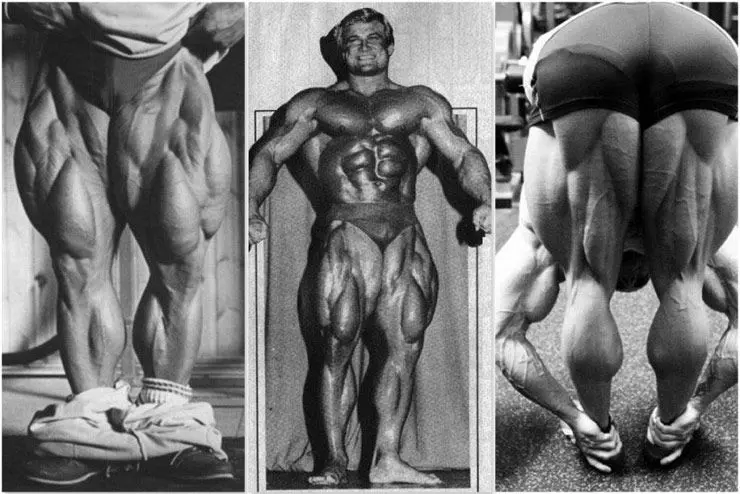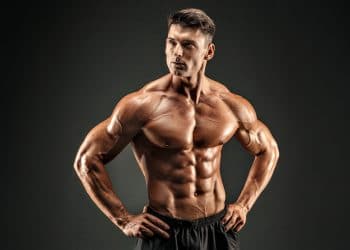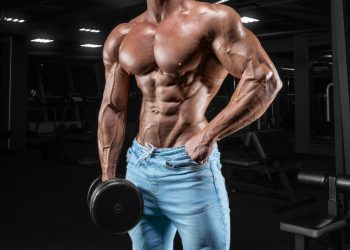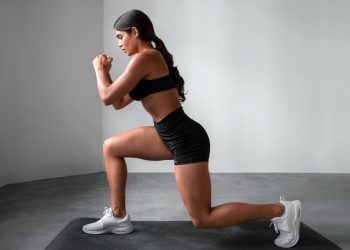A lot of bodybuilders struggle to build an impressive lower body. It’s not a lack of effort that’s the problem. After all, there really is no such thing as an easy leg workout. Instead, the real issue is a lack of training volume.
When you follow a body part split, on paper it looks like each muscle group is trained once a week.
For example:
- Monday – Chest
- Tuesday – Back
- Wednesday – Legs
- Thursday – Shoulders
- Friday – Arms
But, in actuality, you’ve trained your upper body four times and your legs just once. Plus, most upper body muscles are trained 2-3 times, once directly and then indirectly as synergists.
It’s clear that your upper body is trained more often and with more volume than your legs, so it’s no wonder that lower body development often lags behind.
One easy fix for this problem is to train your legs twice a week. This instantly rebalances your program and should lead to increases in lower body hypertrophy.
Level Up Your Fitness: Join our 💪 strong community in Fitness Volt Newsletter. Get daily inspiration, expert-backed workouts, nutrition tips, the latest in strength sports, and the support you need to reach your goals. Subscribe for free!
However, just like your do with your upper body, it’s worth emphasizing different muscles in each leg workout. That way, you can make sure you develop your legs to their maximum muscular potential.
The easiest way to do this is to think in terms of quadriceps-dominant and hamstring-dominant leg exercises.
Like your biceps and triceps, and your chest and back, this separation of opposing muscle groups will ensure that you train the muscles on the front of your legs as much as those on the rear.
While you could stop reading now and head off and write your own twice-a-week lower body workout for massive legs, we’ve saved you the trouble and have designed one for you!
So, if your lack of leg size is getting you down, use this program to build a lower body you can be proud of.
Twice-A-Week Lower Body Split – Workout #1
According to the Weider priority principle, you should always train your weaknesses first. This makes the best use of both your energy and time. Most bodybuilders tend to have underdeveloped hamstrings compared to their quadriceps, so, for this split program, you’ll be training your hammies first. Needless to say, many of these exercises also involve your glutes, which often work hand-in-hand with your hamstrings.
Of course, if you’ve already got well-developed leg biceps, you are free to change these workouts around. However, for most lifters, bringing up the hamstrings is a priority.
Hip-Dominant Workout
| # | Exercise | Sets | Reps | Recovery |
| 1 | Deficit deadlift | 4 | 6 | 2 minutes |
| 2a | Leg curls | 3 | 8-12 | 90 seconds |
| 2b | Romanian deadlift | |||
| 3 | Barbell hip thrust | 3 | 12-15 | 60 seconds |
| 4 | 1 ½ reps leg curl | 1 | 50 | N/A |
| 5a | Standing calf raise | 4 | 8-12 | 90 seconds |
| 5b | Ankle jumps | Max reps |
Twice-A-Week Lower Body Split – Workout #2
Your second lower body leg workout of the week targets your quadriceps. Train your quads 2-3 days after your hamstrings so you are well recovered and can give this workout your all.
Knee-Dominant Workout
| # | Exercise | Sets | Reps | Recovery |
| 1 | Front pause squat | 4 | 6 | 2 minutes |
| 2a | Leg extension | 3 | 8-12 | 90 seconds |
| 2b | Sissy squat | |||
| 3 | Heels elevated goblet squat | 3 | 12-15 | 60 seconds |
| 4 | Short-step lunges | 1 | 50 per leg | N/A |
| 5a | Seated calf raise | 4 | 8-12 | 90 seconds |
| 5b | Tip-toe farmer’s walk | Max distance |
Twice-A-Week Lower Body Split – Exercise Instructions
If you are thinking of trying this program, you should already be pretty familiar with most of the exercises in it. That said, there are a couple of unusual movements that you may not have done before.
So, get the most from your training time by making sure you know how to do each and every exercise and that you can do them correctly. If any of the exercises are new to you, start with lighter weights and only increase them once you are confident you’ve mastered the movement.
Workout # 1 – Hip Dominant
This workout is all about the hamstrings and glutes…
1. Deficit deadlift
Conventional deadlifts are already an effective hamstring and glute exercise, but this variation makes them even more so. By standing on a 4-6” step, you take your hips through a larger range of motion which increases posterior chain engagement. Take care not to round your lower back during this exercise, as doing so could lead to injury.
Learn how to do deficit deadlifts here.
2a. Leg curls
Leg curls isolate your hamstrings. You can do lying, seated, or standing leg curls as preferred. They’re all great exercises and are pretty much interchangeable. Just make sure you really squeeze the weight up and do not use momentum. If you have to kick the weight up, it’s probably too heavy.
Follow the links to learn how to do lying leg curls, seated leg curls, and standing leg curls.
On completion, immediately go to the next exercise – Romanian deadlifts.
2b. Romanian deadlift
Where leg curls are an isolation exercise for your hamstrings, Romanian deadlifts (RDLs) are a compound exercise that also hits your glutes and hamstrings. Doing leg curls before RDLs is a form of pre-exhaust training that will allow you to push your hamstrings beyond their usual point of failure. Use as large a range of motion as you can for RDLs without rounding your lower back.
Learn more about Romanian deadlifts here.
3. Barbell hip thrust
After two types of deadlift, your lower back is probably beginning to fatigue. However, your glutes and hamstrings still have more to give, so we’re going to work around this temporary weak link!
Barbell hip thrusts are a very effective posterior chain exercise that’s also lower back-friendly. This is a powerful movement, so don’t be afraid to go heavy. You can also train to failure in complete safety, providing you use large diameter weight plates.
Level Up Your Fitness: Join our 💪 strong community in Fitness Volt Newsletter. Get daily inspiration, expert-backed workouts, nutrition tips, the latest in strength sports, and the support you need to reach your goals. Subscribe for free!
Learn how to do barbell hip thrusts here.
4. 1 ½ reps leg curl
Yep, you’re doing leg curls again, but this time things are a bit different. Instead of doing regular reps, you’re going to use the 1 ½ rep method to maximize muscle engagement.
Also, instead of doing several sets, you’re just going to crank out 50 reps in as little time as possible. Rest when you need to, but no longer than necessary. Treat the 50 reps as one long set broken up with brief rests.
If possible, use a different type of leg curl to add some extra variety to your workouts. So, if you did lying leg curls earlier in this workout, do seated leg curls now.
How to do it:
- Use a lying or seated leg curl machine as preferred.
- Bend your knees and curl your feet into your butt.
- Extend your legs halfway.
- Curl the weight back up to your butt.
- Extend your legs and lower the weight all the way down.
- That’s one rep – only 49 left to do!
5a. Standing calf raise
After all that hip-dominant training, it’s time to shift focus onto your calves. Unfortunately, many people find it hard to increase calf size. But, again, that’s probably due to a lack of training volume and frequency. So, as well as training your upper legs twice a week, you’re also going to train your calves twice, too.
Start your lower leg workout with some heavy standing calf raises. Learn more about this classic calf-builder here. Then, on completion, go straight to the next exercise – ankle jumps.
5b. Ankle jumps
Athletes who do a lot of sprinting and jumping tend to have large, powerful calves. This exercise provides your lower legs with an effective plyometric workout. This is an excellent way to finish your regular calf training program.
How to do it:
- Stand with your feet together and your hands by your side.
- Keeping your knees as straight as possible, jump up and down on the spot by pushing off your toes. Do not let your heels touch down.
- Continue for as many reps as possible.
- Jump from side to side to work the lateral (side) aspect of your calves.
- Too easy? Hop on one leg instead or hold dumbbells in your hands.
Workout # 2 – Knee-Dominant
This workout focuses on your quadriceps…
1. Front pause squat
While all types of squats work your quadriceps, front squats are particularly quads-dominant. They involve more knee flexion and a more upright torso, ensuring your quadriceps do most of the work.
To make them even better for building massive quads, you’re going to pause for 2-3 seconds at the bottom of each rep. This will increase time under tension, load and stretch your quads, and make every rep harder and, therefore, more productive.
Learn how to do front squats here.
2a. Leg extension
Leg extensions isolate your quadriceps. Use a controlled tempo and moderate weights so you can really focus on squeezing the weight up. Doing leg extensions immediately before your next exercise will really challenge your quads. It’s time to grow or die trying!
Learn how to do leg extensions here.
2b. Sissy squat
Sissy squats are an old-school quads exercise. Using just your body weight, this move hammers your quadriceps by putting you in a very mechanically disadvantageous position. The movement takes a little getting used to, but you’ll learn to appreciate this powerful quad-builder once you get a feel for it.
How to do it:
- Stand in a doorway or next to a wall or post for balance. Rise up onto your tiptoes and brace your abs.
- Push your hips forward, lean back, and squat down as far as you can. Keep your body straight and try to push your knees forward and well beyond your toes.
- Drive the balls of your feet into the floor and stand back up.
- Tense your thighs at the top of each rep and repeat.
3. Heels elevated goblet squat
The heels elevated goblet squat is another very quad-centric squat variation. Raising your heels pushes your knees forward and allows you to keep your torso more upright, both of which increase quadriceps engagement.
Using a single dumbbell or kettlebell means you can ditch the weight if you are unable to complete a rep, making this a good exercise for training to failure.
How to do it:
- Place two bumper weight plates on the floor about hip-width apart. Alternatively, use a length of wooden plank. Stand with your heels raised and the balls of your feet on the floor.
- Hold a kettlebell or dumbbell in front of your chest and just below your chin. Pull your shoulders down and back, brace your core. Look straight ahead.
- Keeping your torso upright, bend your knees, and squat as deeply as you can without rounding your lower back.
- Stand up, stopping just short of locking your knees to keep the tension on your muscles.
- Descend again and repeat for the required number of repetitions.
4. Short-step lunges
Lunges are a great lower body exercise that works your hamstrings, glutes, and quadriceps simultaneously. However, taking a much shorter step makes them far more quads-centric, which is why that’s the variation you’ll be doing in this workout.
How to do it:
- Stand with your feet together and your arms by your sides. Pull your shoulders down and back and brace your core.
- Take a small step forward.
- Bend both legs and lower your rear knee down so it’s just behind the heel of the leading foot. Keep your torso upright.
- Push off your front leg to return to the starting position and repeat.
- Hold dumbbells if necessary (it probably won’t be!)
- Do 50 reps per leg in as few sets as possible.
5a. Seated calf raise
Seated calf raises work your soleus, which is the lowermost calf muscle. Enlarging your soleus will help lift the gastrocnemius or upper calf muscle, making the entire calf complex bigger. A well-developed soleus also adds a pleasing shape to the calves.
Learn how to do seated calf raises here.
5b. Tiptoe farmer’s walk
Walking on tiptoes might seem like an odd end to a workout, but it’s actually a great way to build your calves. Have you ever noticed how a lot of overweight people have HUGE calves?
It seems that walking around while carrying a lot of weight could help your calves grow. This exercise is designed to simulate this effect.
How to do it:
- Hold a heavy dumbbell in each hand using straps if you need to reinforce your grip.
- Rise up onto your tiptoes.
- Without lowering your heels, walk around your training area until your calves are pumped and burning.
- You could also do this exercise with a barbell across your upper back.
Related: Farmer’s Walk Guide: How-To, Muscles Worked, Variations, and Benefits
Related Workout Splits:
- Best 3-Day Workout Split Routine
- 4-Day Split Workout: 10 Weeks To More Growth and Power
- 4-Day Upper Lower Split For Hypertrophy and Strength
- Best 5-Day Dumbbell Workout Split
- Best 5-Day Workout Split Routine
- 12 Best Workout Splits
- 7 Effective Training Splits For Guaranteed Muscle and Strength Gains
- The Pectoral Split – Two Workouts Per Week for Perfect Pecs
- The Functional Training Split: Overview, Benefits and Sample Workouts
- Full-Body Vs. Split Workouts: How to Choose
- Bro Split: The Ultimate Guide
Wrapping Up

Unless you are genetically gifted, one lower body workout a week is probably not enough to build massive, bodybuilder-sized legs. Training your quads and hamstrings in the same session may also mean that your legs aren’t getting the training volume they need to grow.
Friends don’t let friends skip leg day, or so the popular meme says. But maybe those same friends need to take things further and encourage twice a week leg training?
So, if your upper body development overshadows your legs, or you just want to emulate the Quadfather Tom Platz, it’s time to start training your legs more than once a week. Follow this workout for the next 2-3 months to bring your legs up to par with your upper body.











